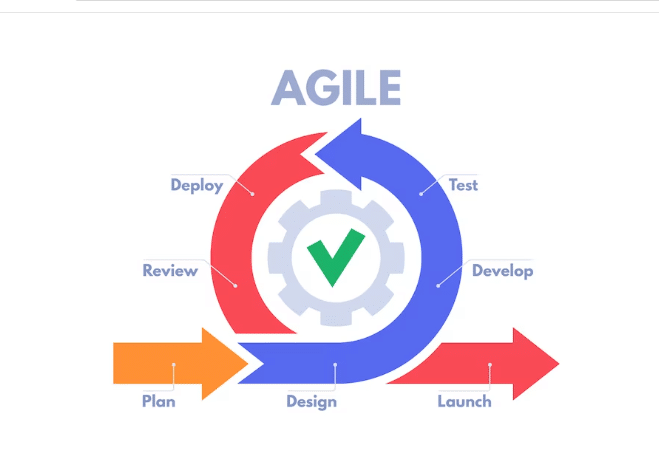What is Agile?
Agile in business is a mindset and set of practices that enable organizations to respond quickly and effectively to change. It is a departure from traditional, plan-driven approaches, which are often inflexible and slow to adapt.
Key characteristics of agile in business
-
Customer focus: Agile organizations prioritize customer needs and feedback, continuously refining their products and services to meet those needs.
-
Small, iterative cycles: Work is divided into small, manageable cycles, allowing for frequent delivery of value to customers.
-
Empowered teams: Agile teams are empowered to make decisions and take ownership of their work.
-
Continuous improvement: Agile organizations foster a culture of continuous learning and improvement, adapting to new information and feedback.
What are the Benefits of Agile in Business?
-
Increased speed: Agile organizations are able to deliver products and services to market faster than traditional organizations.
-
Reduced risk: Agile organizations can identify and address problems early in the development process, reducing the risk of costly failures.
-
Improved customer satisfaction: Agile organizations are more responsive to customer needs, leading to increased customer satisfaction.
-
Increased innovation: Agile organizations are more likely to innovate, as they are able to adapt quickly and capture new ideas and market trends.
How to Implement Agile in Business
In today’s dynamic business landscape, characterized by rapid change and fierce competition – traditional, rigid methodologies are no longer enough. To thrive in this environment, businesses must embrace agility, a set of values and practices that prioritize adaptability, collaboration, and continuous improvement. Implementing Agile is not simply adopting a new set of tools or processes; it’s about fundamentally transforming your company culture and mindset. Below we share the main steps to implementing Agile in your organization.
-
Start small: Don’t try to transform your entire organization overnight. Start with a pilot project or team and gradually scale up your agile practices.
-
Get buy-in from leadership: Agile requires a cultural shift, so you need to have buy-in from senior management.
-
Train your people: Agile requires new skills and mindsets. Ensure your employees are trained in agile principles and practices.
-
Choose the right tools: There are a number of tools that can help you implement agile, such as project management software and collaboration tools.
-
Measure and track progress: Agile is about continuous improvement, so you need to continuously measure and track your progress.
More Great Reading Material on Agile
1. The Agile Manifesto
The Agile Manifesto is a declaration of values and principles that guide the development of agile software. It emphasizes customer focus, iterative development, and continuous improvement.
2. The Scrum Guide
The Scrum Guide is a definitive guide to the Scrum framework, which is one of the most popular agile methodologies. It provides detailed instructions on how to implement Scrum in projects of all sizes.
3. Kanban for Software Development
Kanban for Software Development is a book by David Anderson that explains the Kanban method, which is a visual scheduling system that can be used to improve flow and reduce waste in software development.
4. Extreme Programming Explained
Extreme Programming Explained is a book by Kent Beck that explains the Extreme Programming (XP) methodology, which is a set of practices that emphasize code quality, simplicity, and communication.
5. Agile for Product Development
Agile for Product Development is a book by Alan Shalloway and Joanne Molesky that provides a practical guide to implementing agile in product development.
Being Agile with KPI Fire: How-to?
KPI Fire is all about using its features to fuel continuous improvement and adapt to changing circumstances while achieving measurable goals. Here are some ways to make it happen:
Embrace Transparency and Feedback:
- KPIs in the Spotlight: Ensure everyone on the team has access to relevant KPIs and understands their connection to project goals. This fosters shared ownership and accountability.
- Fire Up Feedback Loops: Utilize KPI Fire’s reporting capabilities to solicit regular feedback from stakeholders and team members. This helps identify roadblocks and opportunities for optimization early on.
- Celebrate and Learn: Don’t just track numbers, analyze them! Use KPI Fire’s insights to understand what’s working and what’s not. Celebrate successes and use failures as learning opportunities to adjust your approach.
Prioritize Flexibility and Iteration:
- Sprints with Fire: Align your KPI tracking with your sprint cycles. This allows you to measure progress, adjust priorities, and make data-driven decisions within each iteration.
- Real-time Adjustments: Don’t be afraid to adapt your KPIs and targets as needed. KPI Fire’s dynamic dashboards make it easy to monitor progress and adjust course if needed.
- Embrace Experimentation: View KPI Fire as a tool for experimentation. Use it to test different approaches, measure their impact, and iterate towards better results.
Foster Collaboration and Communication:
- KPI Champions: Assign ownership of specific KPIs to team members. This creates a sense of responsibility and encourages knowledge sharing within the team.
- Open Communication Channels: Use KPI Fire’s reporting tools to facilitate open communication about progress and challenges. This fosters trust and helps everyone stay aligned.
- Celebrate Collective Wins: When KPIs are met, celebrate the achievements as a team. This reinforces the importance of collaboration and motivates everyone to strive for continuous improvement.
Concluding Remarks
Remember, KPI Fire is a useful tool. With that said, the real agility resides in the way you use it in line with an agile mindset and solid methodology. By embracing transparency, flexibility, and collaboration, you can turn KPI Fire into a powerful engine for driving agile success.




